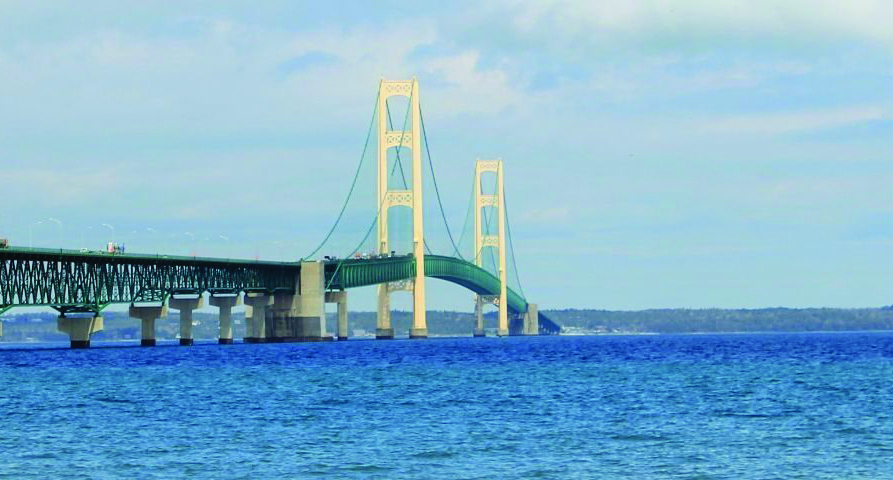Army Corps of Engineers publishes Line 5 Environmental Impact Statement

The Mackinac Bridge is pictured. (Courtesy photo)
MARQUETTE — On May 30 the U.S. Army Corps of Engineers, Detroit District published the Line 5 Tunnel Project Draft Environmental Impact Statement amidst signifiant regional concerns about the environmental impact of the Line 5 Pipeline, which is owned by Canadian company Enbirdge and transports oil and liquid natural gas from Superior, Wisconsin to Sarnia, Ontario.
“Based in part on initial public input, USACE determined that the proposed Project could
significantly affect the quality of the human environment, and that the Department of the Army permit decision is a major federal action requiring preparation of an Environmental Impact Statement,” read the released statement.
“The EIS identifies and assesses a reasonable range of alternatives, as well as the direct, indirect, and cumulative environmental consequences of those alternatives, in order to identify options to avoid and minimize detrimental effects on the quality of the human environment.”
“The Line 5 Tunnel Project is a proposal by Enbridge Energy, Limited Partnership (Enbridge) to construct a tunnel beneath the Straits of Mackinac in Lake Michigan,” said Carrie Fox, public affairs specialist for the U.S. Army Corps of Engineers.
“The tunnel would house a replacement segment of Enbridge’s Line 5 pipeline, which transports crude oil and natural gas liquids. The Detroit District is reviewing Enbridge’s permit application (File LRE-2010-00463-56-A19) pursuant to Section 10 of the Rivers and Harbors Act of 1899 and Section 404 of the Clean Water Act for a Department of the Army permit.”
The Environmental Impact Statement is meant to assess potential impacts of building a tunnel around Line 5 across the Straits, as well as potential impacts of project alternatives such as installing a layer of gravel over the existing pipeline.
The potential impacts being considered are to land use and recreation, aesthetics, water resources, biological resources, cultural resources, geology, soils, transporation and navigation, air quality, noise and vibration, socioeconomics, reliability and safety.
“In addition to its consideration of cultural resources in the EIS, the Corps of Engineers is separately evaluating impacts to historic properties, as well as impact avoidance, minimization, and mitigation measures, in accordance with Section 106 of the National Historic Preservation Act,” said Fox.
“The Corps of Engineers is also conducting a treaty rights analysis in consultation with federally recognized Tribes to determine if the proposed Line 5 Tunnel Project would impinge upon or abrogate treaty rights. Findings of the Section 106 process and treaty rights analysis will be presented in the Record of Decision following release of the Final EIS.”
“The Detroit District continues to prepare the Final EIS and comply with all applicable legal and policy requirements, including its federal trust responsibility to Tribal Nations, the National Historic Preservation Act, the Endangered Species Act, and the National Environmental Policy Act,” said Detroit District Commander Lt. Col. Wallace Bandeff. “These processes will inform the District’s permit decision.”
This Draft Environmental Impact Statement has been released after years of talk and initial comments, a summary of which can be found in Appendix B of the DEIS, which is linked at the bottom of this article. Common themes of public comment include concerns about pipeline safety and spills, public health and safety and greenhouse gas emissions.
“Enbridge has a long history of accidents, spills, and inadequate cleanup,” reads one of the comment summaries under the topic heading of “Comments on the Applicant (Enbridge)” in the released Draft Environmental Impact Statement. “Degradation of their systems has gone unreported. Enbridge is responsible for the two largest inland oil spills in U.S. history, and has a long record of negligence, regulatory violations, and cover ups.
While the record of decision date is this fall, The Detroit District is conducting a 30-day period for public comment from May 30 to June 30, 2025. Comments can be made using the following methods:
The Line 5 Tunnel EIS website at https://www.line5tunneleis.com/comment-here-new/.
Virtual public meetings being held on Wednesday, June 18 from 1-4 p.m. and Wednesday, June 25 from 5-8 p.m.
Written comments postmarked before June 30 and mailed to Line 5 Tunnel EIS 6501 Shady Grove Road, P.O. Box 10178 Gaithersburg, MD 20898
“Public participation is an important part of the National Environmental Policy Act process to ensure a thorough environmental analysis, and an effective, consistent and well-informed decision,” said Bandeff.
The full statement is available online on the Line 5 Tunnel Project website at https://www.line5tunneleis.com/draft-eis/.
Annie Lippert can be reached at 906-228-2500, ext. 542. Her email address is alippert@miningjournal.net.




